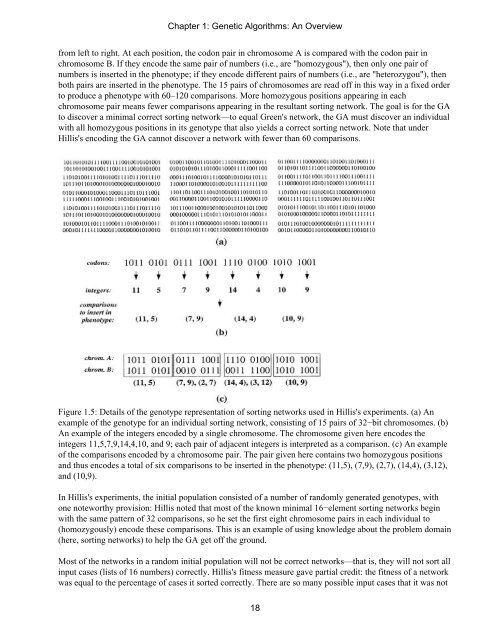An Introduction to Genetic Algorithms - Boente
An Introduction to Genetic Algorithms - Boente
An Introduction to Genetic Algorithms - Boente
You also want an ePaper? Increase the reach of your titles
YUMPU automatically turns print PDFs into web optimized ePapers that Google loves.
Chapter 1: <strong>Genetic</strong> <strong>Algorithms</strong>: <strong>An</strong> Overview<br />
from left <strong>to</strong> right. At each position, the codon pair in chromosome A is compared with the codon pair in<br />
chromosome B. If they encode the same pair of numbers (i.e., are "homozygous"), then only one pair of<br />
numbers is inserted in the phenotype; if they encode different pairs of numbers (i.e., are "heterozygou"), then<br />
both pairs are inserted in the phenotype. The 15 pairs of chromosomes are read off in this way in a fixed order<br />
<strong>to</strong> produce a phenotype with 60–120 comparisons. More homozygous positions appearing in each<br />
chromosome pair means fewer comparisons appearing in the resultant sorting network. The goal is for the GA<br />
<strong>to</strong> discover a minimal correct sorting network—<strong>to</strong> equal Green's network, the GA must discover an individual<br />
with all homozygous positions in its genotype that also yields a correct sorting network. Note that under<br />
Hillis's encoding the GA cannot discover a network with fewer than 60 comparisons.<br />
Figure 1.5: Details of the genotype representation of sorting networks used in Hillis's experiments. (a) <strong>An</strong><br />
example of the genotype for an individual sorting network, consisting of 15 pairs of 32−bit chromosomes. (b)<br />
<strong>An</strong> example of the integers encoded by a single chromosome. The chromosome given here encodes the<br />
integers 11,5,7,9,14,4,10, and 9; each pair of adjacent integers is interpreted as a comparison. (c) <strong>An</strong> example<br />
of the comparisons encoded by a chromosome pair. The pair given here contains two homozygous positions<br />
and thus encodes a <strong>to</strong>tal of six comparisons <strong>to</strong> be inserted in the phenotype: (11,5), (7,9), (2,7), (14,4), (3,12),<br />
and (10,9).<br />
In Hillis's experiments, the initial population consisted of a number of randomly generated genotypes, with<br />
one noteworthy provision: Hillis noted that most of the known minimal 16−element sorting networks begin<br />
with the same pattern of 32 comparisons, so he set the first eight chromosome pairs in each individual <strong>to</strong><br />
(homozygously) encode these comparisons. This is an example of using knowledge about the problem domain<br />
(here, sorting networks) <strong>to</strong> help the GA get off the ground.<br />
Most of the networks in a random initial population will not be correct networks—that is, they will not sort all<br />
input cases (lists of 16 numbers) correctly. Hillis's fitness measure gave partial credit: the fitness of a network<br />
was equal <strong>to</strong> the percentage of cases it sorted correctly. There are so many possible input cases that it was not<br />
18






